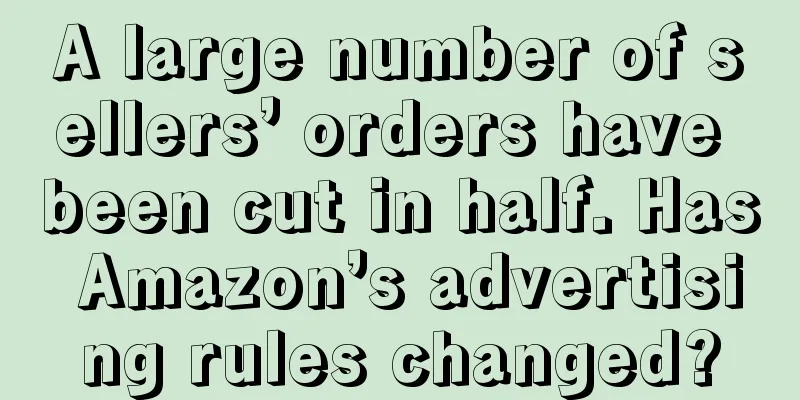|
MarketPlace Pulse data shows that in 2022, Amazon sellers' operating costs accounted for more than 50% of total sales revenue, 10% higher than five years ago. One of the main culprits for the cost increase is the ever-increasing advertising costs.
According to the profit and loss statements provided by the sample, Amazon advertising and promotional expenses account for 15% of most sellers. In order to increase exposure and gain more traffic, advertising has almost become a necessary choice for most sellers, which has also led to a continuous increase in Amazon advertising bids.
Nowadays, as the competition for going overseas becomes increasingly fierce, the competition for platform traffic is also becoming fierce. Therefore, any slight change in Amazon's advertising rules may have a ripple effect and affect the subsequent operations of sellers. Recently, many sellers have reported that Amazon advertising has undergone some "abnormal" changes since May. A large number of sellers’ orders have been cut in half. Has Amazon’s advertising rules changed? According to reports, a seller recently reported: "Since May, my advertising settings have not changed much. Even after launching several new advertising campaigns, the daily spending has shown an extremely obvious downward trend. The advertising spending on May 10 was only half of that on May 1. My daily order volume is basically consistent with the trend of advertising spending. The order volume on May 10 was only half of that at the beginning of the month."
▲ The picture comes from Zhiwubuyan
The seller checked the business report and found that the visits to his two stores had basically dropped by about 20%, and the advertising conversion rate had also dropped by about 30%. According to past experience, the orders for the seller's store products generally rebounded significantly in May. However, in recent months, the sales volume has been lower than the previous month. This situation is not unique to this seller. Many of his peers have recently lamented that they can't spend money on advertising, the conversion rate has dropped, and the CPC bidding has increased.
The seller not only speculated that the overall environment of the Amazon platform might have changed again. Many sellers mistakenly believed that competitors raised CPC to grab advertising space, and raised their advertising bids.
In fact, many sellers have keenly sensed the changes in Amazon advertising in recent times:
"I feel the same. Starting from May 6th, the Acos of advertising was less than 20. Now that I have started BD, I can't even spend all the advertising money. The Acos has soared to 40%." "I personally feel that the traffic is getting less and less, and most of the traffic is eaten up by low-priced links. I feel that the higher the average order value, the harder it is to do business." "Orders dropped by about 25%, advertising costs dropped by about 30%, and profits dropped by about 5%. It feels like the traffic has dropped. The orders of the top 1-10 in my category have all dropped, and the overall ranking has dropped by about 10." "We had been doing well in the main keyword ads and natural positions, but suddenly everything changed within a week. The main keywords we used to have no search volume, and were replaced by keywords that used to have only dozens of searches. The search volume directly increased to tens of thousands, and the final result was a sharp drop in orders."
Based on feedback from multiple parties, many sellers have seen a sharp drop in ad exposure and a surge in ACOS since May. Even if they raise their CPC bids, they are unable to secure premium ad space. The direct impact is a significant drop in ad conversion rates, and a sharp drop in both traffic and sales.
A seller revealed the current promotion status of an old product: "I have the same BID. During the peak order period, the cost has decreased. If the advertising is extended to one day, the cost can be spent. The number of ad slots for keyword placement has not changed. This means that the bid price during the popular order period should have increased. Other products have pushed me down, and when they have used up their bids, I will take their place."
In response to the above phenomenon, sellers currently have different opinions, mainly focusing on the following aspects:
- Amazon platform rules have changed
- The overall traffic of the platform has decreased, and Amazon has given priority to allocating traffic to large links with stable sales.
- There are more and more new products entering the category. To get higher exposure, you may need to bid higher based on the current product weight.
Some sellers also said that they were probably influenced by Temu. As inflation in foreign countries continues to increase, people's consumption level is declining, and they prefer to compare prices from multiple sources when shopping. Temu's ultra-low pricing and attractive discounts attract more and more consumers. For example, during Mother's Day, sellers had poor sales, while Temu launched a 50%-90% discount campaign, which inevitably made many sellers suspect that "consumers were diverted."
Is Amazon's advertising logic Google-like? Changes to the search box may exacerbate internal competition In fact, Amazon's advertising rules have indeed changed recently. Not long ago, a seller reported on the forum that the Broad matching logic of Amazon SP ads has changed, and some unexpected customer search terms have appeared. For example, the structure of a placement word was originally A+B. According to the previous rules, no matter how to match the customer search terms, it would contain the two roots A and B. But now, there are forms where the roots appear alone, such as A+C or B+C.
Amazon SB advertising's Broad has always followed the above logic, not only including words expanded from keywords, but also replacements with synonyms and near-synonyms. Now SP advertising has also begun to implement the same rules, which is almost exactly the same as the Google advertising model, which means that the accuracy of advertising traffic is likely to be reduced.
"If you run ads according to the new rules, the accuracy of this matching mode may not even be as good as automatic ads. In this case, using broad matching to promote will make the keyword promotion process ineffective. According to the current data, the effectiveness of this matching rule has not yet been reflected. Perhaps the Amazon platform itself is also intentionally adopting this rule in a progressive manner." A seller admitted.
According to feedback from some sellers, this change actually occurred as early as the peak season last year, but the probability was not frequent. It might appear once or twice out of hundreds of clicks, but the frequency has increased significantly in recent times.
From this change in advertising rules, sellers also keenly captured two messages:
First, the competition for traffic is becoming increasingly fierce. Faced with the situation of too many sellers and too little traffic, the platform began to sell the traffic that sellers don’t need; Second, the platform’s traffic supply may have reached a bottleneck. In the future, Amazon may have to think about how to diversify advertising display methods to meet the needs of sellers.
It is worth noting that recently many sellers have discovered that Amazon’s drop-down search box has also been adjusted , and the words that appear are no longer the high-traffic words of the past, but are all unknown small long-tail words.
Specifically, the core words in the past were A+B+C. When A+B was entered in the search box, A+B+C would appear directly in the drop-down box, but now there is only A+B+C+D, D+A+B+C, and so on.
One seller said that his current daily order volume has dropped by about 150 orders compared to the day before May Day, and the rankings of similar competing products are also basically declining. In addition, the conversion rate of the big words in another link's automatic advertising, which originally had a 15% conversion rate, has now dropped to less than 5%, but it has produced many long-tail words that have generated conversions.
In summary, in the past, traffic words could help sellers place orders, but now sellers have to actively add long-tail words, which has also led to an increase in the overall advertising budget. Some sellers speculate that adding more words through the drop-down box means increasing the number of ad placements, and the consumption of a single click on a long-tail word is getting higher and higher, which in turn stimulates more intense competition.
Overall, the various recent rule changes seem to be inextricably linked. It remains to be seen whether Amazon is just testing the waters and will formally make large-scale adjustments in the future.
|










